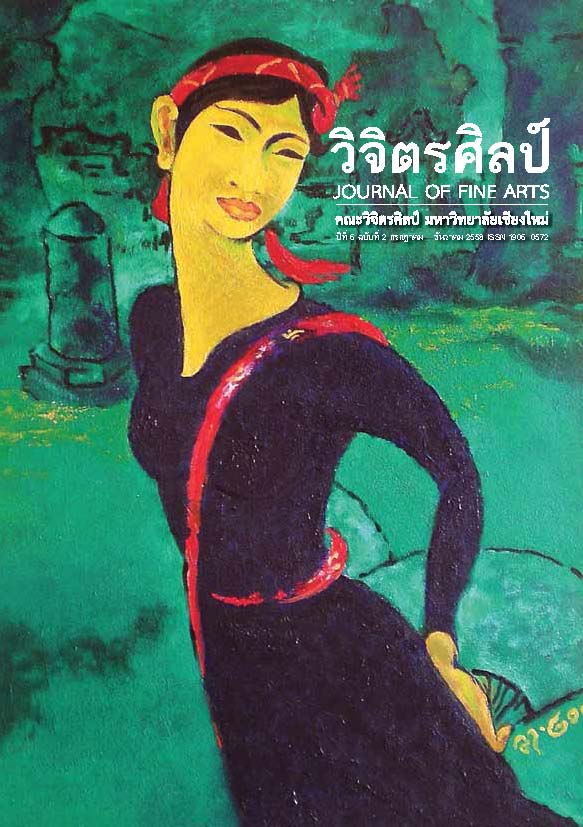รูปแบบและลักษณะทางดนตรีในการแสดงดาระจังหวัดสตูล
Main Article Content
Abstract
1) ประวัติความเป็นมา สันนิษฐานว่า ดาระมาจากประเทศซาอุดิอาระเบีย ผ่านมายังประเทศอินโดนีเซีย มาเลเซีย เข้าสู่ทางภาคใต้ของประเทศไทย ที่จังหวัดสตูลเมื่อกว่า 300 ปีมาแล้ว ท่ารำนำมาจากท่าของกวาง บทเพลง นำมาใช้ 5 เพลง ผู้ถ่ายทอดมี 3 รุ่น
2) มีบทบาทต่อชุมชนในด้านสร้างความบันเทิง การสร้างสุขภาพในชุมชน เป็น สื่อพื้นบ้าน การถ่ายทอดวัฒนธรรมและการถ่ายทอดองค์ความรู้
3) มีวิธีการฝึกหัดและถ่ายทอดการแสดงทั้งด้วยตัวศิลปินเอง วิธีพี่สอนน้อง การเปิดค่ายอบรม และด้วยการทำเป็นสื่อวีซีดี
4) การแสดงประกอบด้วยนักดนตรี เครื่องดนตรี ผู้ขับร้อง บทเพลง นักแสดง ชุดแต่งกาย
5) ขั้นตอนการแสดง เรียงลำดับจากเพลงตะเบงะเจ๊ะ เพลงอมจารีกำ เพลง ดียาโดนียา เพลงซีฟาดดารีกันตงและเพลงฮอดามี การตีรำมะนาด้วยเสียง 3 เสียง ท่ารำไม่มีชื่อเรียก
โครงสร้างเพลงส่วนมากมี 5 ท่อน ประโยคเพลงมี 2 ประโยคเป็นประโยค คำถามและประโยคคำตอบ บันไดเสียงใช้แบบ Hexatonicscale, Pentatonic scales และ Diatonic Scale หลักเสียงและโหมดเสียงใช้ Aeolian มากสุด Mixolydian และ Ionian รองลงมา โครงสร้างทำนองส่วนมากมี 3 ท่อน มี ทำนองเดียว วรรคเพลงและวลีของทำนองมี 2 – 6 วลีทำนอง ใช้กระสวนจังหวะ 4 – 7 กระสวน ใช้กระสวนทำนอง 2 – 6 กระสวน มีการพัฒนาแนวทำนอง จากทำนองหลักออกไป 3 – 9 ทำนอง กลุ่มเสียงทำนองร้องแบ่งวลีละ 1 – 2 กลุ่มเสียงพิสัยของทำนองร้องอยู่ระหว่างคู่ 6 minor ถึงคู่ 9 major การดำเนิน ทำนองเป็นลำดับขั้นและกระโดดคู่ 3 ความสัมพันธ์ของคำร้องกับทำนองส่วน มากเป็นแบบ Syllabic และ Neumatic
Musical Forms and Characteristics of Darah Performance in Satun Province
This research, utilizing qualitative research method, aimed to 1) study the musical culture of Darah performance in Satun province, 2) analyze the musical forms and styles of Darah performance. The findings of the research reveal the following.
1) the performance traces its origin in Saudi Arabia, passing through Indonesia, Malaysia and into Satun province southern Thailand more than 300 years ago. The dance styles of the performance are taken from the movement of deer. The music only five songs are traditionally played through three generations of musicians and singers.
2) The Darah performance plays a role for the community in the creation of entertainment, creating healthy communities, serving as local media, acculturation and knowledge transfer.
3) Performance practice and knowledge is passed on by the performers themselves through teaching by senior performers to apprentices, opening of training camp and producing the VCD for propagation.
4) Performance elements consist of musicians, musical instruments, singers, songs, performers and costumes.
5) performance procedures are arranged as follows: The music starts with TabengNgajeh. Omjarikam, DiyaDoniya, Sifat Dari Kantong, and Hodami musical pieces. This is accompanied by the playing of the rebana (tambourines) with three tones and there is no name for the dance styles.
The structure of the songs contains five stanzas with two sentences, i.e. question and answer sentences. Hexatonic, Pentatonic and Diatonic Scales are used throughout. Aeolian is used most frequently, followed by Mixolydian and Ionian. Most melodicstructure is of three stanzas and mono-melody, whereas musical line and melodic phrase consist of 2-6 phrases. The melody utilizes 4-7 rhythmic patterns with 2-6 melodic patterns. 3-9 melodies have been developed from the main melody. Sound melody is divided into 1-2 groups. The range of sound melodies is between 6 minor intervals to 9 major intervals. The melodic sequence utilizes the scale and a jump into the third intervals. Lyrics and melodies are related mostly in the Syllabic and Neumatic.


